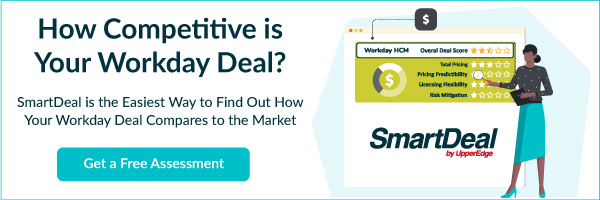- Jeff Lazarto
- Reading Time: 5 minutes

If you are a Workday customer, there are six common mistakes you need to avoid when expanding your Workday footprint by adding new solutions.
1. Not Assessing Value of Current Deal
Before entering any negotiation with Workday, you should look at your current Workday subscription and determine actual value realization from all solutions, identify any pain points, and evaluate the competitiveness of your pricing and commercial terms. All of this information is critical in obtaining the most value from your Workday investment.
Expanding your footprint is very strategic for Workday as they are able to obtain a greater slice of the applications running your business and increase vendor lock-in. Any value loss identified in your current subscription should be addressed as a prerequisite for expanding your solution footprint, as your negotiation leverage will only decrease as you add more Workday solutions.
2. Purchasing Off Cycle From Renewal Date
Workday lives for this type of transactional approach because it provides them with greater negotiation leverage. Your current Workday subscription is not factored into the negotiation unless you take a holistic approach in your negotiations. Simultaneously, negotiating an early renewal of your existing subscription is a great way to increase your negotiation leverage.
We realize it is not always convenient or in the best interest of the business to hold off purchasing new solutions until your Workday subscription is up for renewal. But not addressing your upcoming renewal as part of this new purchase is an opportunity wasted. Each time you expand your footprint, Workday is gaining more control of your business as their solutions are more heavily relied on by your organization. Plus, renewals typically occur every 3 years, allowing Workday to increase fees on an annual basis unless you have negotiated renewal term pricing protections.
Workday knows full well that switching to another solution is costly and not very feasible, so your renewal negotiation leverage is very limited. Every time you expand your subscriptions, whether it is by increasing your FSE counts or adding solutions, presents a negotiation opportunity of which you must take advantage. Those who fail to do so will find themselves paying much higher subscription fees than their competitors for the same Workday functionality.
3. Bundling SKUs Into One Subscription Fee
We have seen Workday proposals and executed order forms that have multiple solution SKUs listed but only include pricing for the entire bundle. There is no line item pricing and therefore no pricing transparency. The concerns with this type of pricing are as follows:
- It is extremely challenging-to-impossible to break out the pricing for each SKU to determine pricing competitiveness;
- If you have future growth, you will need to purchase incremental FSEs for the entire bundle and not by line item; and
- If you ever want to remove SKUs in the future, you will not be able to validate the accuracy of the new pricing because you have no visibility as to how Workday is allocating the bundled pricing across each line item.
We recommend all Workday customers obtain line item pricing in their proposals and include this level of detail in the order form. This will prevent you from having to rely on memory as to the pricing breakout and serve as proof for anyone new to the agreement in the future, whether that is from your organization or Workday.
4. Re-Evaluating FSE Worker Categories
Now that you are expanding your Workday solutions, you may have a whole new set of worker classification categories that would be using these new solutions that is different from those workers factored in your original subscription. You will need to review any new workers that will now be using Workday and group them by role or classification, such as field workers, or seasonal workers for the holidays.
Remember that if you have workers that do not easily fit into one of the worker categories, you can request Workday modify the definition of a Workday category or even create a new category with a custom definition that addresses your unique workers. You will just need to clearly articulate why these workers are different and do not fit within the defined worker categories and the applicable percentage that should be assigned to them based on the level of value they provide to your organization.
5. Professional Services Rate Card
You will need to implement your new Workday solutions which will require professional services. Even though Workday maintains a systems implementation partner ecosystem, since your footprint expansion is most likely beyond HR and FI, you will most likely require Workday resources to provide some level of services, even if it is just as subject matter experts to complement your SI partner.
Your subscription negotiation is the perfect time to negotiate a discounted professional services rate card. As mentioned earlier, this is part of a holistic approach to value realization. You need more than just the subscription, you also need services and training, where you can also negotiate discounts. Workday has less flexibility in discounting services and training rates then they do with their solution subscriptions, so the potential savings might not be large, but it can still be meaningful and offset some unforeseen cost overruns during your implementation.
6. Failing to Obtain Rebundled Functionality Rights
One of the downstream risks is that Workday can decide to repackage or rebundle functionality into different solutions. This is not uncommon among software vendors. What typically happens is that over time certain solutions are more desirable than others, but the vendor wants customers to adopt these other solutions and feels that if customers had access to them then they would use them. So, the vendor will take the most desired solutions and break out the functionality into differently named solutions, then add the less desired functionality across these newly named solutions.
The issue for customers is that come renewal time, you may have to purchase multiple solutions just to maintain the same functionality you had been using for years from one solution. This can be a significant cost increase, especially if you really do not want the added functionality. So the rebundled functionality right provides you with the right to maintain access to previously licensed functionality at no additional charge, other than your contractual renewal pricing uplift. You get access to the newly named solutions, but you may not use any functionality you were not previously using without paying additional fees.
Negotiations and Opportunities
You need to make the most of each negotiation opportunity. You do not need to take a scorched earth approach to negotiations by fighting for every little concession, but you should maximize your leverage to ensure you are securing a fair and competitive deal that will enable your organization to extract as much value from your Workday investment as possible.
Post a comment below, follow me on Twitter @jeffrey_lazarto, find my other UpperEdge blogs, and follow UpperEdge on Twitter and LinkedIn. Learn more about our Workday Commercial Advisory Services.
What to Read Next:
Related Blogs
Workday’s Latest AI Announcements: What You Need to Know Before Entering the Negotiation Room
The Key to Getting Your Workday Negotiations Right
Evaluating Workday’s LDP: Critical Insights for Small & Mid-Sized Businesses
About the Author

